![]() Chapter 5 of 7 in the DesignWare history thread.
Chapter 5 of 7 in the DesignWare history thread.
OK, so I had the basic idea of a computer interacting with a human, and discovered that programmed instruction had been tried, and computer-based education was new (PLATO) and decided to build a software language that could transcend proprietary computer hardware through computer-science linguistic tricks. I build LINGO, and MultiTutor, and then the Courseware Design System.
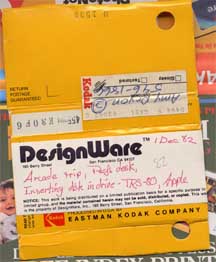 And lo-and-behold microcomputers came into existence. And it was 1980. I started DesignWare on a $3000 limit credit card. In those days this was maybe 2x a public school teacher’s monthly salary. I was a university professor with two kids just going into school, and yes $3000 would last a couple of months. So I didn’t even sink it into the company, I just used it to buy equipment, took no salary, and got those few gifts (remember Steve gave me that Apple II #2515, and so on with Atari and others). I got some small consulting gigs, personally, with Digital Equipment Corporation and Xerox Learning Systems. I did some forward thinking, and I wrote some reports. This I parlayed into an idea I had to write a high school book on computer literacy. I had met computer literacy people already. This included Art Luehrman at Lawrence Hall of Science, and Bob Albrecht, the founder of People’s Computer Company in Menlo Park (who I must have met in 1975), and many others.
And lo-and-behold microcomputers came into existence. And it was 1980. I started DesignWare on a $3000 limit credit card. In those days this was maybe 2x a public school teacher’s monthly salary. I was a university professor with two kids just going into school, and yes $3000 would last a couple of months. So I didn’t even sink it into the company, I just used it to buy equipment, took no salary, and got those few gifts (remember Steve gave me that Apple II #2515, and so on with Atari and others). I got some small consulting gigs, personally, with Digital Equipment Corporation and Xerox Learning Systems. I did some forward thinking, and I wrote some reports. This I parlayed into an idea I had to write a high school book on computer literacy. I had met computer literacy people already. This included Art Luehrman at Lawrence Hall of Science, and Bob Albrecht, the founder of People’s Computer Company in Menlo Park (who I must have met in 1975), and many others.
So I developed a description and I pitched SRA (Science Research Associates shortened their name to initials, thank goodness) with the idea that their high school division might publish this book. But I wasn’t going to just write it, I wanted them to pay for writing it. And I wanted to include a series of programs that kids could use, in BASIC, on personal computers. There were few computers in schools, so there was really no market for this at the time. But Apple was pushing forward on the vector of becoming an educational computer, so it made sense that if we could write this book, with programs and exercises, and if Apple was successful, we could be a big hit.
I got the contract. It wasn’t huge, but it was the equivalent of at least a couple of years of salary for a developer—I was going to hire others to help me write, and to write the programs. So I first outlined the book and then drafted a lot of material. The core was mine, but I needed collaborators. I rapidly decided that the best way was to hire writers and programmers to get the book done. We would as a group be the “corporate author” of each work.
My boys, Gabriel and Aaron were enrolled at Live Oak School in San Francisco, and the head, Lesley Czechowicz was at that point considering her options. Knowing her as a detail-oriented woman who I thought would be dynamite with writing, editorial and overseeing the programming, I was able to convince Lesley to join and help build the development crew. Over time, Lesley nurtured this crew of fairly diverse types, which included hard-core programmers, others we called “programmer’s assistants” (these days might be a more junior programmer), and others who wrote, edited and built content on the educational side. I was on the road much of the time, visiting Chicago and New York trying to convince educational publishers they should commission DesignWare to get them into educational software. I was quite successful.
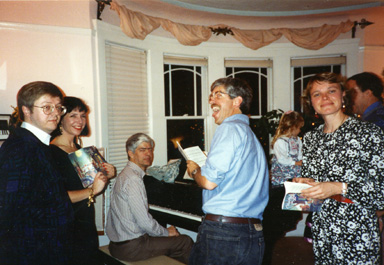 By the end of 1981 we probably had a development group of a half dozen. And I think overall we had about 15 employees working, under the corporate author model I described above, by the end of 1982. We have more party photos than office photos, and we continued to hold annual reunions for many years.
By the end of 1981 we probably had a development group of a half dozen. And I think overall we had about 15 employees working, under the corporate author model I described above, by the end of 1982. We have more party photos than office photos, and we continued to hold annual reunions for many years.
Oh, so here’s a couple of office photos just so we can’t be accused of just goofing off entirely all the time. Can you tell they’re staged? How interested, really, is Michael in that side of the Crypto Cube? But look at the vintage Apple II and the really big 19-inch TV. Who even has a CRT (cathode ray tube) any more, except maybe some railroad terminal somewhere? Maybe not even there.
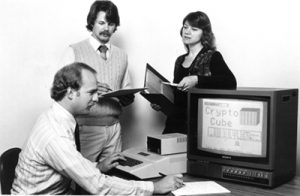
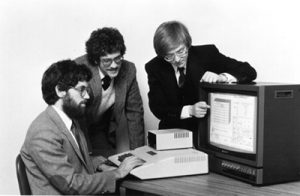
But speaking of goofing off, we actually did make a practice of taking the entire staff out for pizza and video games in the arcades. To gain inspiration for possible new products. It was very edutaining. We all loved that.
Coming off an initial year of $140,000 in sales (on my $3000 cards-worth of credit) I’d say that in calendar 1981 we had around $250,000 in sales, perhaps more because I just don’t have those records, because of books being written, programs being written, and private-label work we were doing for publishers. Among them Harcourt, SRA, Reader’s Digest. Not big projects particularly, but we were actually a big fish in that pond, as there were few other individuals or companies doing this at the time. We got a lot of publishers into software in just a few years.
In or near 1982 three things happened. First, we had a good taste of what it took to write books and programs and we were anxious to do it under our own label, not as author for another publisher. Second, Bill Bowman and David Seuss, of Spinnaker Software, had the idea of building their own independent publisher of edutainment titles, and they came to talk with DesignWare about serving as author of some titles for them. Third, I started investigating venture capital.
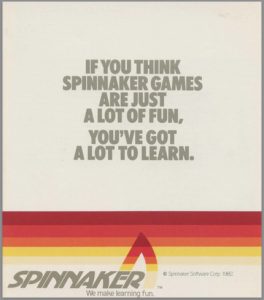 It all came together like this. First, Spinnaker signed with us for two titles. Half their initial rollout. I liked these guys and what they were doing, and I really wanted to do it too. Their timing was fortunate as they provided capital, and eventually some reasonable royalties, and we didn’t have to build production capacity right away. Second, we got first-round financing from Vanguard Associates of Palo Alto, with Jack Gill as a member of our board of directors. They also brought Tom Whitney, formerly with Apple, to the board. I believe that because of the Spinnaker deal, I was able to keep more insider control of the ownership and management of the company. This turned out to be pivotal in its survival. I was, and remained for five years, the President, Chairman of the Board and CEO. [Hey, Spinnaker team, we still have a PDF of one of your catalogs. Very creative stuff.]
It all came together like this. First, Spinnaker signed with us for two titles. Half their initial rollout. I liked these guys and what they were doing, and I really wanted to do it too. Their timing was fortunate as they provided capital, and eventually some reasonable royalties, and we didn’t have to build production capacity right away. Second, we got first-round financing from Vanguard Associates of Palo Alto, with Jack Gill as a member of our board of directors. They also brought Tom Whitney, formerly with Apple, to the board. I believe that because of the Spinnaker deal, I was able to keep more insider control of the ownership and management of the company. This turned out to be pivotal in its survival. I was, and remained for five years, the President, Chairman of the Board and CEO. [Hey, Spinnaker team, we still have a PDF of one of your catalogs. Very creative stuff.]
With the advent of venture capital, we brought some new leadership in. I had just hired Sharmon Hilfinger (she’s now a playwright and non-profit founder) as VP of Marketing, but our investors wanted someone with more experience in the field. Personally, I love starting fresh and bringing in people with just enough experience, but a willingness to play hard and learn a new game. Our investors suggested, and suggested with a little arm-twisting, that we hire Peter Rosenthal from Atari to join the new crew. First of all, I doubted that we could get him. I had met Peter, liked him and what he was doing, and couldn’t imagine he’d leave a company like that, so poised for success, to join a start-up. But he did. This was a great learning experience for me. I learned that experience (in this case, Peter’s experience in marketing) often suggests different tactics than I might think. If we were going to move from corporate author to big-time publisher, and sell our goods through computer stores, and then through Toys-R-Us and other big retailers, it was a different game, and we needed help with that. Great lesson for a computer science guy like me. Peter and I still talk over lunch now, 35 years later, several times a year.
You know, here’s another observation. I’ve got a PhD in Computer Science. Peter has a PhD and worked in biomedical research. How did two guys with PhDs end up in corporations, in education, in software, and not as research scientists? I’ll just say that on occasion the PhD has given just a little edge to me in sales situations. Just once in a while, because it added credibility specifically on the software side of the equation. But it was a great, and a necessary change, for me, to go from academia to business.
Other people I should mention beyond Lesley, and George, Sharmon, and Peter are our incomparable “Mr. Computer” Alan (Al) Macy, who is now a sci-fi author, and I want to call out Sally Bowman Alden (who did the hard work in our marketing group, and who later started Computer Learning Month), Mary Shek (now of D2M) who put together our physical manufacturing, Tom Paderna (who started in manufacturing in our warehouse and moved along into marketing later at Logitech and then T/Maker while I was there, now Adobe). There are lots of other individual success stories in the group. It was wonderful to have every one of them there, and in some cases I know we gave a boost, while in other cases I wish we had been able to do more. But what a group!
By 1983 we had moved into publishing our own titles under our label. [Read the next installment of the story] [Or return to the start of the story]
As usual a well written, authentic and heartwarming retrospective view of a very interesting and exciting time in the personal computer industry. Jim glosses over the hard work and steely nerves he needed to keep this enterprise moving forward through thick and thin.
It was a pleasure to work in this environment where all of us were pulling together to produce a meaningful product line. Jim created and managed a diverse and talented group of people.
My memory includes all of the work as well. Memory focuses, however, on what we were trying to accomplish and how we got there, while the hard work becomes one big lump. I process stress by chatting about the issues. This affects those around me. So they also had to have steely nerves, or they became disenchanted and decided I was a bother. There was some of both.